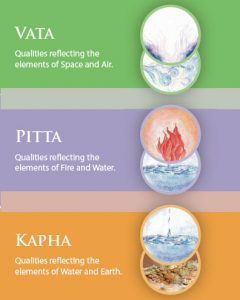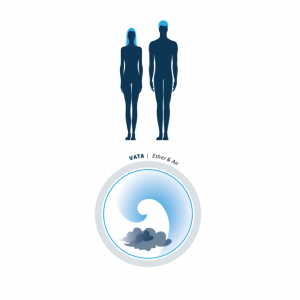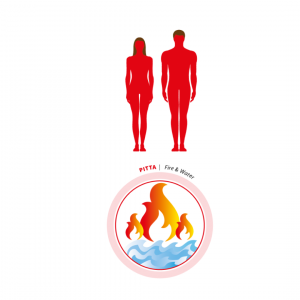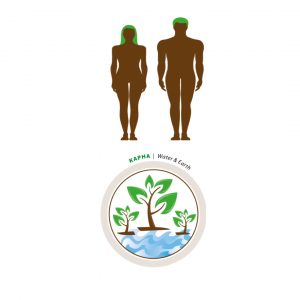Ayurveda and the three Doshas: Live self-compassion with the help of natural medicine
 Ayurveda gives us a deep understanding of the relationship between health, the environment, and the mind. It is the traditional system of medicine from India that integrates body, mind, and spirit using a comprehensive holistic approach. Ayurveda places great emphasis on prevention and encourages the daily maintenance of health. How to create this balance of body, mind and consciousness according to one’s own individual constitution and how to make lifestyle changes to bring about and maintain this balance?
Ayurveda gives us a deep understanding of the relationship between health, the environment, and the mind. It is the traditional system of medicine from India that integrates body, mind, and spirit using a comprehensive holistic approach. Ayurveda places great emphasis on prevention and encourages the daily maintenance of health. How to create this balance of body, mind and consciousness according to one’s own individual constitution and how to make lifestyle changes to bring about and maintain this balance?
Every individual is unique and there is no recommendation, diet or lifestyle routine that works for every single person in the same way. Ayurveda teaches that the five basic elements of space, air ,fire, water and earth manifest in the human body as three basic body/mind types or constitutions known as the three Doshas (Vata,Pitta and Kapha). These three govern creation,maintenance and destruction of bodily tissues as well as the assimilation and elimination. Understanding these three is the key balance and maintenance.
The Doshas

“Just as everyone has a unique fingerprint, each person has a particular pattern of energy—an individual combination of physical, mental and emotional characteristics—which comprises their own constitution. This constitution is determined at conception by a number of factors andremains the same throughout one’s life.” Dr. Vasant Lad, a well-known Ayurvedic physician and teacher, gives the best basic explanation of Doshas above. The Doshas are the elements that create the physical body and influence the mind. They determine conditions of growth, aging, health and disease. Typically, one of the three doshas predominates and determines one’s constitution or mind-body type (dosha). Ayurveda treatments focus on alleviating doshic excesses (illness) through the improvement of general lifestyle practices, emphasizing certain foods for certain doshas, herbal remedies, breathing techniques (pranayama), meditation, exercise, right thinking, healthy relationships and yoga postures. Furthermore, the doshas are unbalanced when there is excess accumulation of a Dosha, and it overflows and migrates from its original place in the body to other parts of the body creating toxicity.
Vata Dosha
 The constitution that controls bodily functions associated with all movement in the body, including breathing, circulation of the blood, blinking of the eyes and your heartbeat, is Vata Dosha. This also includes the movement of your thoughts. When Vata is in balance there is creativity and vitality and when out of balance Vata can produce anxiety and fear.
The constitution that controls bodily functions associated with all movement in the body, including breathing, circulation of the blood, blinking of the eyes and your heartbeat, is Vata Dosha. This also includes the movement of your thoughts. When Vata is in balance there is creativity and vitality and when out of balance Vata can produce anxiety and fear.
Vata individuals are light, excitable, and lively, with changing moods. They are quick to learn and grasp knowledge and information, but they are also quick to forget. They are sensitive to cold temperatures, with a tendency toward cold hands and feet as well as discomfort in cold climates.
Vatas tend to have irregular daily routines. They usually have a slim physique, dry skin and dry hair and don’t perspire much. They respond to stress with fear, worry, and anxiety, especially when out of balance and tend to have rapid, rambling thoughts. They often act impulsively, yet Vatas are very artistic and creative by nature.
Pitta Dosha
 Pitta is the constitution that controls the body’s metabolic systems, including digestion, absorption, nutrition, and body temperature. When in balance, Pitta creates contentment and intelligence. When out of balance Pitta can manifest as ulcers, irritability, and anger.
Pitta is the constitution that controls the body’s metabolic systems, including digestion, absorption, nutrition, and body temperature. When in balance, Pitta creates contentment and intelligence. When out of balance Pitta can manifest as ulcers, irritability, and anger.
People with a Pitta constitution are determined, of medium physique, strong, and toned in musculature. They often have fair or reddish skin and may have freckles and sunburn easily. They are often uncomfortable in the sun or heat and perspire easily. Their eyes can be sensitive to light, they have strong digestion and appetite and may become irritated if they miss or delay a meal.
They tend to be sharp-minded, have good concentration and focus, are assertive, self-confident, and entrepreneurial. They are good public speakers and leaders but can become authoritarian when unbalanced. When a Pitta person’s dosha is balanced he or she is passionate, romantic and competitive.
Pittas will become irritated and angry when out of balance. When under stress, they may be aggressive, demanding, and manipulative. Other signs of Pitta imbalance are early graying or loss of hair and debilitated eyesight. Common physical problems would include acne, rashes or inflammations of the skin, boils, ulcers, heartburn, acid stomach, IBS and insomnia.
Kapha Dosha

The energy that controls growth in the body is called Kapha. It supplies lubrication to all body parts, provides cushioning and moisture, and maintains the immune system. Kapha Dosha often has soft hair and supple skin and a tendency to have large and almond-shaped eyes and a low, soft voice.
Reliable and loyal, Kapha is physically strong with a good immune system and with a sturdy and thick body frame, having the most stamina of all constitutions. They are slow of speech and reflective of thought. They can be slower to learn, but once something is learned it is never forgotten.
Kaphas are down-to-earth, easygoing, relaxed, patient, affectionate and loving. They are forgiving, compassionate, nonjudgmental and good listeners.
When Kapha constitutions are balanced they express love and forgiveness, stability and steadiness. Gentle and calm, Kaphas strive to maintain harmony and peace in their surroundings and within. They are not easily upset and are often a point of grounding for those around them.
When out of balance, Kapha can lead to insecurity, envy, and attachment. This can manifest as weight gain, possessiveness, or depression. Kaphas don’t acclimate well to cold or damp weather. Physical issues include colds and congestion, respiratory problems, asthma, allergies, sluggish digestion, and obesity.
Compassion

The five elements are the cause of our physical body, the building blocks of our constitution. There are clear indications when there exists an excess of a Dosha. For example, with excess vata, there can be mental, nervous and digestive disorders, including low energy and weakening of all body tissues. With excess pitta, there is toxic blood that gives rise to inflammation and infection. With excess kapha, there is an increase in mucus, weight, edema, and lung disease, etc. To understand how your Dosha affects your body and mind you must determine your Dosha and begin to see your thoughts and habits from an observer’s perspective (as if seeing yourself through a compassionate mother’s eyes)…you are a combination of elemental energies that create specific tendencies and natures within. That perspective gives a sense of acceptance of yourself as you are right now in this moment. This is the starting point in healing.
Learn your Dosha and make friends with yourself. Be willing to truly know who you are, what you’re doing or not doing, and why. Then become your own best ally and do whatever is necessary to stay on the path of self-care, healing and self-love. From there the health and balance you seek will follow quite easily.
“When you look deeply you begin to understand, the moment when you understand, compassion is born in your heart. And then it is possible for you to forgive.” – Thich Nat Han
Be willing to let go of the past to move forward into a future of wellness. Change your diet, change your job, transform relationships and change your life. Reach down inside yourself and find the dedication to heal yourself. In the end no one else can heal you…others can only assist you. Each effort you make is your glory walk to the valley of healing.
 A special thanks to Jill of Aruna Ayurveda for sharing a the above introduction to the natural medicine of India. To learn more about your own Dosha and to go deeper to map-out your plan to healing contact Karmuka Yoga or Jill directly for an online or in-person (after covid) Ayurvedic Wellness Session here.
A special thanks to Jill of Aruna Ayurveda for sharing a the above introduction to the natural medicine of India. To learn more about your own Dosha and to go deeper to map-out your plan to healing contact Karmuka Yoga or Jill directly for an online or in-person (after covid) Ayurvedic Wellness Session here.
Disclaimer
The sole purpose of this article is to provide information about the tradition of Ayurveda. This information is not intended for use in the diagnosis, treatment, cure, or prevention of disease.
